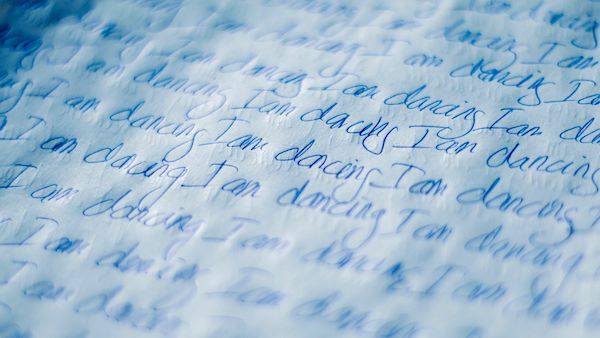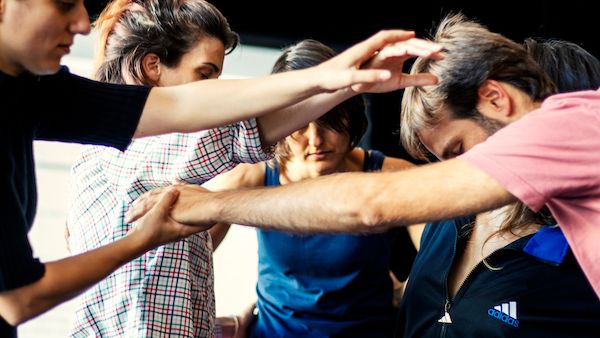In August 2021 I was invited by Cellule d’Essai to be part of a few days of open research into choreography and dance in Lyon, France. What follows is the report I wrote after that time.

This writing is based on a lie. This lie has to do with the difficult we. In other words, it is written by one person on behalf of many. In truth I do not wish to speak for them and their experiences, and nor can I. But, you see, things happened in that room and one of the things I agreed to do when I said “yes” to Cellule d’Essai was to attempt to describe some of those things (but not all of them). I write we because we shared space and time together, not because we had a singular experience, and certainly not because I think I know what happened for each of us.
We are eleven people who live in different parts of Europe. Our combined aged is 394. We are not special, just a group of neoliberal jugglers: dancers and people who make dances. For three days — 30 August - 1 September 2021 — at the Maison de la Danse in Lyon we became Cellule d’Essai.
In the big windows directly above the main entrance to the theatre are big see-through portraits of famous choreographers. Some of them are dead, some of them are alive. They are almost all alone — singular stories of success or perhaps luck. They are each an I as they look down at us behind our masks. Early on we discuss writing biographies and the ways in which biographies are an attempt to make claims to authority and accreditation. We resisted claims to authority and accreditation. That is, we attempted to avoid telling each other things we have done that prove our worth or value as contemporary dancer-choreographers. We wondered who we are and who we can be without these kinds of factual biographical details. Perhaps this was a way of taking a brief time-out from the difficulty of being an I as a choreographer. That is, given our lives are spent justifying our practices, ambitions and desires as individual(ist) choreographers, why not just stop that? That we do not need to simply keep climbing from opportunity to opportunity.
To stop like this is a difficult thing to do, not least because how does any group make anything happen while working collectively? Who proposes? Who decides? Who says yes? How many say yes? Who says no? The two people of Cellule d’Essai — before we became eleven — made a single proposition: Let’s gather things, ideas, actions and activities and put them in a box. Then, when in doubt (or even when we are filled with certainty), we can go back to the box and let those scraps of paper guide us. The first piece of paper said: Fly! (the exclamation mark is beautiful and important). And so we flew.

We danced. We talked. We asked questions. We breathed each other’s air. We touched. We ate together. We put on masks. We took off masks. We stumbled. We took responsibility for dance. We tidied up. We wrestled with what it means to be a choreographer, and with what it means to be able to sustain a choreographic practice for a long time. We were awkward, relaxed, tense, joyful, uncertain and occasionally bullish. In short, we were people working together and making sense of that work.
One word that came up more than once was alliances; perhaps this was because each of us in different ways felt the need to build coalitions. Isn’t that what we social human beings do? We recognised the paradox that any claims on behalf of the individual — the eyes and Is on the windows of the theatre — are a dysfunctional lie; that we all need each other. That in truth we are useless without alliances. This is more than alliances as a strategy or con to prop up individual success; it is alliances as a way to recognise that we are empty without one another. That we are dependent on one another. At one stage we explored who and what we are dependent on; we asked, “How can we shape our dependencies?”
We thought about the ways our identities as artists are affirmed by institutional recognition. Occasionally, some binaries got in the way (binaries are fantastic like that): To play or be played. To choreograph or be choreographed. To work or be worked. To exploit or be exploited. To stand or be stood on. To voice or be voiced. To write or be written. To shape or be shaped. To make or be made.
In some of the work we did we noticed the ways in which things — ideas, actions, people, noises — can dominate. How does each of us consume or offer space and energy in a group? Occasionally, the phrase “compositional point of view” became a lens we applied to help us make sense of what was happening; like a familiar crutch, or a way of imagining being on the outside looking in. There were moments of expressing anxiety and uncertainty as if in a dysfunctional relationship with choreography and dance. What is stopping each of us from leaving? How much responsibility can each of us bear and sustain? How far might we fall if we were to say no? What might we fall into? What is the least that we can do that would enable us to take care of ourselves and contribute to the common good? This is the ethics and logic of the self versus the ethics of the common good.


These are some words that seemed to dance with us occasionally in the studio: research versus production, identity, courage, dependence, dancing, institutions, survival, email, struggle, dancing (again), biography, agency, time, exhaustion, money, the logic of production, saying no, and understanding the compromises each of us is prepared to make.
In one conversation someone said how dance is like a box of clues designed to stimulate, nourish and challenge; a box of clues with many solutions. How do we deal with doubt, fear and vulnerability? How do audiences deal with doubt? As if both the people who make and the people who watch are constructing something (and not always together). And at what point do we share? What assumptions do we make about the mode or method of presentation? What if what is most rich is in process? How might that be shared?
We reflected on the days while lying on our backs, and at the end we karaoked to Con te partirò.
These are our names: Koraljka Begovic, Simone Camargo, Benjamin Coyle, Francesco Dalmasso, Simon Ellis, Jule Flierl, Marie Gourdain, Claire Lefèvre, Ariadna Gironès Mata, Lola Maury, and Stefania Tansini.
Photos of us by Jule Flierl or Simon Ellis.